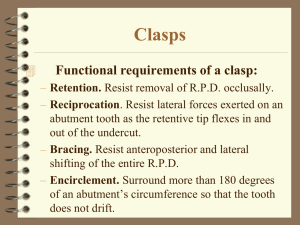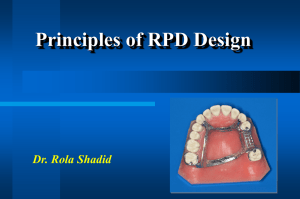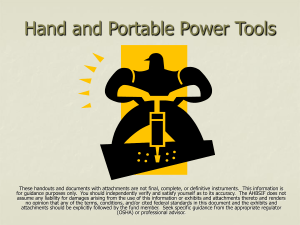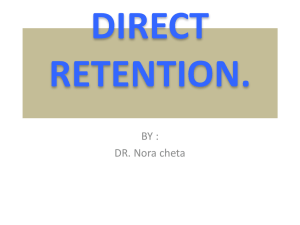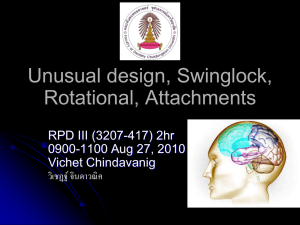RPD_files/Esthetic RPD`s & Prec Att Undergrad
advertisement
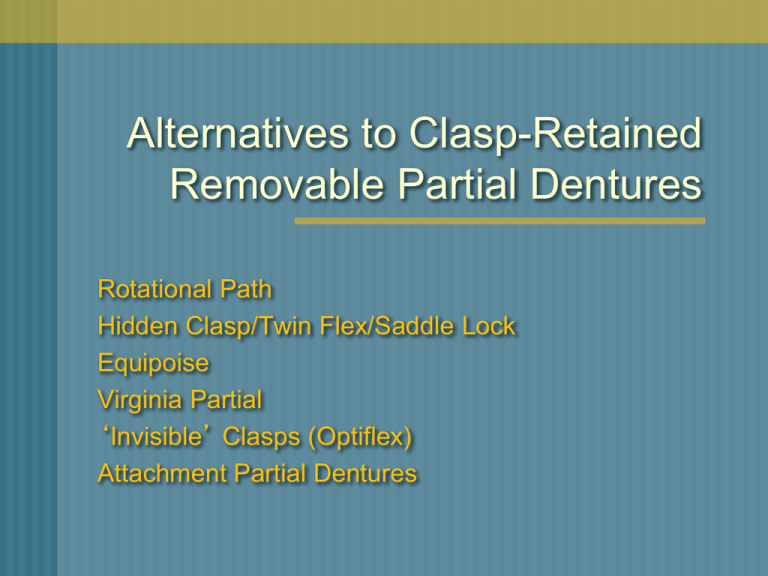
Alternatives to Clasp-Retained Removable Partial Dentures Rotational Path Hidden Clasp/Twin Flex/Saddle Lock Equipoise Virginia Partial ‘Invisible’ Clasps (Optiflex) Attachment Partial Dentures Fractured Abutments Kennedy Class IV (Category I) Rotational Path RPD Elimination of clasps on one side of RPD Place rigid element into undercut Rotate other end into place (clasps) Place in Undercut, Rotate Clasp into Place Principles Large deep rests to provide support, reciprocation Reciprocation from adjacent teeth End that rotates must not have rigid elements in undercut Preparations Sufficient reduction if placing a crown Avoid undercuts in rests Prepare axis close to rotational axis Dovetail if no other element to keep abutment from moving Effective RPD Design Underutilized Potential Problems Impossible to adjust Modification spaces (large blockout) Require sufficient undercut Require ability to hide metal guiding plate Requires good laboratory support Blockout Hidden Clasp/Twin Flex Uses retentive undercut on proximal surface Requires sufficient undercut Space for clasp movement - hygiene Hidden Clasp Designed by lab (retentoscope) If insufficient retention, labs tend to bring the clasp around to facial Variable retention (Soo et al, 1996) Hidden Clasp Results Equipoise Lingual back-action clasp reciprocated Minimal facial clasp display. 1mm Equipoise Equipoise Greater preparation Minimal Stress release Kennedy Class III situations Visible metal mesial embrasure display Flexible ‘Gasket’ RPD’s Virginia Partial - elastomeric Cu-Sil - elastomeric Flexite/Valplast - thermoplastic No clasps Cu-Sil Flexible ‘Gasket’ RPD’s Difficult to adjust, polish Tend to tear, rough surface Cu-Sil Virginia Removable Partial Denture Silicone gasket around teeth Compensates for lost bone/gingival height Patients generally favour Virginia Removable Partial Denture Hygiene Caries potential Liner lifespan Virginia Removable Partial Denture Hygiene Caries potential Liner lifespan ‘Invisible’ Clasps (Optiflex) Non-metal, white Opti•Flex Coating applied to metal clasps ‘Invisible’ Clasps (Optiflex) Thick, white, ugly clasp? Porous (plaque) Fatigue Bulky (comfort) Other alternatives Bonding composite to clasp arm Anodizing clasp arm Precision & Semi-Precision Removable Partial Dentures Overview of Prosthetic Attachments Attachments Type of direct retainer Metal receptacle (matrix = female) attached to • An abutment or • A prosthesis Closely fitting component (Patrix = male) mates with the receptacle Uses for Attachments Fixed Partial Dentures Lack of draw between abutments Stress distribution Uses for Attachments Removable partial dentures Comfort • Less Bulk • Within confines of Crown Uses for Attachments Removable partial dentures Esthetics Retention Uses for Attachments Overdentures • Retention Classifications of Attachments By type of Prosthesis Intracoronal / Extracoronal Precision / Semi-Precision Intracoronal Attachments Female portion of attachment within a crown Extracoronal Attachments Portion of attachment outside of crown/retainer contours Precision Attachments Box or key way One path of insertion Allows minimal to no rotation Precision Attachments Milled prostheses Semiprecision Attachments Less intimate fit Some leeway or resilience Principle to relieve stress Overdenture Attachments Bars Balls Studs Magnets Overdenture Attachments Scope of Practice Generally beyond scope of GP GP’s should be aware of possibilities Advantages Esthetics Hygiene Advantages Stress distribution deep rest directs stress along long axis Single path of movement Advantages Comfort - fewer lingual components Disadvantages Cost Maintenance Critical More complex types need more maintenance If poorly maintained • Catastrophic failures • Patient response Disadvantages Extra tooth preparation for intracoronal If insufficient reduction • over-contoured retainer Major reduction of non-restored teeth Disadvantages Overdenture flange must draw with attachments Can’t place flange in some undercuts Disadvantages Technique sensitive Lab Parallelism Casting Processing acrylic Disadvantages Technique sensitive Dentist Tissue base impression Relating Base to teeth Contraindications Short clinical crowns Large pulps Dexterity problems Bruxers? Design Considerations Tissue Health Critical Compressible tissue - recovery Affects occlusion Patient Instructions Routine adjustments required Prevent major problems Dental checkups twice a year Advise type of attachments Record attachment type and replacement # in chart Summary - Attachment RPD’s Attractive Advantages Maintenance critical and costly Long term success if: Dentist uses utmost care Patient follows care & maintenance regime If dentist or patient careless, ultimately fails Summary - Esthetic Alternatives No panacea significant disadvantages with some designs Costs Managing expectations is important Initially Long-term
